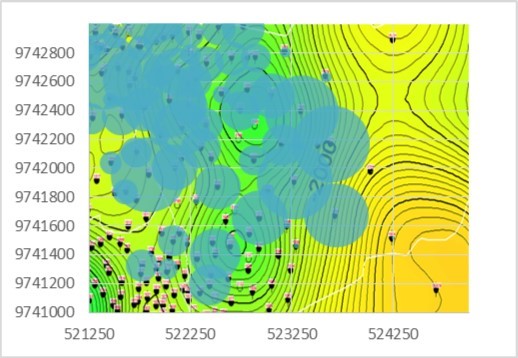Multivariate Analysis for the Selection of the Best Production Zones of the Santo Tomás Formation, Section 68, Gustavo Galindo Velasco field

Published 2018-12-20
Keywords
- Brownfields,
- Multiple Linear Regression,
- Experimental Design
How to Cite

This work is licensed under a Creative Commons Attribution 4.0 International License.
Abstract
In order to have an optimum development of hydrocarbon reservoirs, it is necessary to use a numerical simulation of reservoirs in which a large amount of geological and reservoir parameters are needed; therefore, an adequate record of information is required throughout the life of a field. In brownfields with poor geological characterization and lacking an adequate information record such as the Gustavo Galindo Velasco field, it is difficult to implement a numerical simulation model since its low production does not justify the high execution costs and historical adjustments of a simulation project. Being a highly depleted field, with a history of production of more than a hundred years and with low formation pressures; and considering also the complex geology of the Peninsula of Santa Elena and the lack of information in certain sections of the field; it makes it impossible to carry out common reservoir studies that limit investments for the development of the field. With the limited information available, a multivariable statistical analysis of the Santo Tomás Formation of Section 68 of the Gustavo Galindo Velasco Field is performed by using: Experimental Design (DOE), to determine the most influential factors in the accumulated production and through this way to be able to characterize the zones with greater potential of production; and Multiple Linear Regression, as a method of behavioral analysis accumulated oil production under certain parameters and conditions.
Downloads
References
2. Guardia, V. M. D., Torres, M. C., Arenas, C. E. V., Castro, R. H., Toro, G. M., & Mendoza, O. B. (2011). Análisis de riesgo y simulación de monte carlo en la valoración de proyectos– aplicación en la industria de los hidrocarburos. Revista Fuentes, 9(2).
3. Guerrero-Martin, C. A., Montes-Páez, E., de Oliveira, K., Cristina, M., Campos, J., & Lucas, E. F. (2018, June). Calculating Asphaltenes Precipitation Onset Pressure by Using Cardanol as Precipitation Inhibitor: A Strategy to Increment the Oil Well Production. In SPE Trinidad and Tobago Section Energy Resources Conference. Society of Petroleum Engineers.
4. Montgomery, D. Diseño de Experimentos, 2001. Segunda Edición. Pag. 170-384. Limusa Wiley
5. Malone, P., FANTIN, F., TUERO, F. Informe Geológico y de Reservorios del Área, 1999. Ancón.
6. Pacifpetrol S.A. Informe de Reservorios del Campo, 2012. Ancón
7. Páez, E. G. M., González, F. E. C., & Duarte, C. A. M. (2016). Aplicación de series de tiempo en la realización de pronósticos de producción. Fuentes: El reventón energético, 14(1), 79-88.
8. Quintero, R. M., Lamus, C. M., Garzón, S. A., Páez, E. M., & cepeda Gómez, F. (2016). Ajuste de la presión anular en pozos con bloqueo por gas para optimización de producción en el campo cira infantas.
Revista Fuentes, 14(2), 65-74.
9. Quintero, Y. A., Triana, R. L., Jaimes, M. G., & Torres, M. L. (2010). Optimización de diseños de fractura hidráulica aplicando estudios geomecánicos. Revista fuentes, 8(2).
10. Sánchez, J. Determinación de las Propiedades de los Fluidos de los Yacimientos del Campo GGV a partir del Uso de Correlaciones Empíricas en Sistemas de Petróleo, Gas y Agua para Cálculo de Factores de recobro y Reservas. (Tesis de tercer nivel, Universidad Estatal Península de Santa Elena, 2014).
11. Tamayo, G. A. V., Consuegra, F. R., & Simancas, M. E. C. (2017). Predicción de flujo multifásico en sistemas de recolección de crudo: descripción de requerimientos. Fuentes: El reventón energético, 15(1), 87-99.